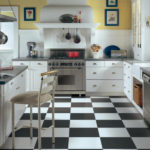
When your refrigerator is busy keeping food fresh and cool, it’s often overlooked. Use these easy fridge cleaning tips for daily care and deep cleaning to keep your fridge sparkling.
The refrigerator is a kitchen workhorse, but you probably don’t clean it as often as other household surfaces. If not maintained regularly, stains and food scraps can build up on the inside and outside of shelves and drawers, while forgotten perishables can smell bad every time the door is opened. To keep your refrigerator in good shape and avoid odors, use these tips to learn how to best clean your refrigerator, inside and out. Gather some natural cleaning supplies and common household items like baking soda, water, dish soap, and dry cloths. Then put your groceries in a cooler and you can start cleaning the refrigerator.
How to Clean Shelves and Drawers in the Refrigerator
First, remove the removable refrigerator shelves, wire mesh, and drawers, then hand wash in hot water and a mild detergent. Allow all glass parts to warm to room temperature before coming into contact with hot water; otherwise they may break. Cover stubborn food stains with a warm damp cloth for a few minutes to soften the stain, then remove with a non-abrasive scrubber. Pay special attention to the bottom of the grille as this area attracts dirt.
How to Clean the Inside of Your Refrigerator
For drawers and shelves that cannot be removed, grab some baking soda and some water on the side of the interior compartment. Clean the inside of the refrigerator with a mixture of 1 part baking soda and 7 parts water. Beware of commercial refrigerator cleaners, as their odor can transfer to food. Work from top to bottom to avoid drips on already cleaned surfaces. Use a toothbrush or toothpick designed for cleaning to reach crevices and crevices that cannot be reached with a cloth, such as B. hinges and other hardware. Dry with a clean towel.
How to get rid of refrigerator odor
If you don’t take the necessary steps, your refrigerator may create an ideal environment for odors. Fortunately, you can get rid of refrigerator odors without harsh chemical cleaners. After rinsing and drying all surfaces, fill an open container with dry baking soda and place it on the bottom shelf to deodorize the refrigerator. This will absorb any future odors that linger around your food, so when you refill your refrigerator, leave it in place.
After the refrigerator has been cleaned and deodorized, put everything back in its place. Now is also a great time to organize and organize your refrigerator. Throw out expired or spoiled food, keep similar items together, and consider using litter boxes and containers to wrap items. You should also engage the services of an Electrician in Nairobi to find out why the fridge is not properly preserving food hence resulting to the odor.
How to Clean a Refrigerator Seal
Pay special attention to the rubber seal around the refrigerator door. It needs regular cleaning to keep it sealed. If you find mold, use warm water and liquid dish soap to remove regular dirt and bleach cleaners. Rinse and dry thoroughly. Then apply a thin layer of Vaseline to the seal so it doesn’t dry out.
How to Clean the Outside of Your Refrigerator
Make your refrigerator sparkle with a good exterior cleaning. Just wipe with a cloth sprayed with an all-purpose cleaner and apply a little extra elbow grease to the handles that collect dirt. Remember to wipe the top of the refrigerator occasionally. While this area may not be exposed to the daily wear and tear of handles and doors, dust can collect there over time.
There are slightly different ways to clean a stainless steel refrigerator, so use these tips to remove smudges and fingerprints. For a quick clean, wipe the surface first with a damp microfiber cloth, then with a dry cloth. If the dirt is more stubborn, try rubbing it with alcohol. Put a few drops of rubbing alcohol on a soft cloth and wipe over the stain. When cleaning stainless steel appliances, be sure to wipe in the direction of the grain.
How to Clean Refrigerator Coils
Even the parts of the refrigerator that you can’t see, such as B. The coils must be cleaned from time to time. While cleaning your refrigerator snake is a little stressful, getting your chores done can help your refrigerator run better and last longer. Follow these steps to clean your refrigerator coil and you can safely take this home maintenance task off your to-do list.
Consult your owner’s manual for specific instructions before you begin. If you can’t find it, look it up online. Most equipment manufacturers have online manuals, and you can find yours by searching for the model number.
No matter what brand or model you have, the first step in cleaning your coils is to unplug your refrigerator. Then find the coils (some on the back of the fridge, some on the bottom). If your refrigerator is on the back of the refrigerator, gently pull the unit away from the wall. Use a coil brush (a long, thin brush, similar to a bottle cleaning brush) to clean the coil. Sweep or vacuum any debris from the floor, put the refrigerator back in place and plug it back in.
For models with coils on the bottom of the unit, remove the grill from the front of the refrigerator. Use a coil brush to thoroughly clean the coil area. Vacuum or sweep up debris and replace the grill before reinserting.
How to Clean a Refrigerator Water Dispenser
To continue enjoying fresh filtered water in the refrigerator, clean the water dispenser thoroughly from time to time. As with refrigerator coils, the instruction manual should be consulted before cleaning. Systems vary by model, and manuals are usually a good source of specific instructions and information on troubleshooting major water dispenser problems. Also refer to the manual for the water cooler and ice maker filter replacement schedule. Replacing the filter as recommended will help keep the dispenser and ice maker in good working order.
Dispenser bowls are prone to water spots and stains. To clean the tray, wipe with a vinegar-based cleaner and dry. If the tray is removable, remove it and clean it in the sink. Be sure to clean under the tray. A soft toothbrush can help access all nooks, crannies, and vents.
How to Get Rid of Mold on the Refrigerator
Because of its cool and sometimes humid environment, refrigerators are prone to mold. To get rid of mold in the refrigerator, avoid abrasive or bleach cleaners. Instead, use baking soda and mix 1 tablespoon in 1 warm water. Wipe down moldy surfaces, then dry thoroughly to remove excess moisture.
It’s very easy to remove some mold from spilled liquids or an empty refrigerator. However, major disasters, such as a flood or a refrigerator full of groceries that are out of service for an extended period of time, may require a more thorough cleaning. in these cases
Contact an appliance repair specialist who can thoroughly inspect your refrigerator and make recommendations. If mold grows inside the refrigerator, simple cleaning will not restore the refrigerator to its original condition, and more advanced measures may need to be considered, such as: B. Recycle the refrigerator and replace it with a new model.
Precautions for Keeping Your Refrigerator Clean
A few simple steps can keep your refrigerator looking (and smelling) fresher for longer. To avoid sticky spills, avoid refilling food containers or spoiled fruits and vegetables in the refrigerator. Immediately throw away anything expired or questionable freshness. Use baking soda and water to wipe down any jars, bottles, or cans with dripping or clumpy lids. Make sure to use a clean towel and dry everything thoroughly before putting it back in place. To make this task easier, use refrigerator items to clean them as you cook and prepare meals. Once in a while you its always nice to outsource your cleaning services form one of the cleaning companies in Nairobi.
Set aside time once a week to sort out spoiled produce or leftovers in the back of the refrigerator. Check the shelf life of dairy products and condiments, and throw away anything that’s expired. Removing these items regularly will prevent odors and sticky spills from returning to a clean refrigerator.







